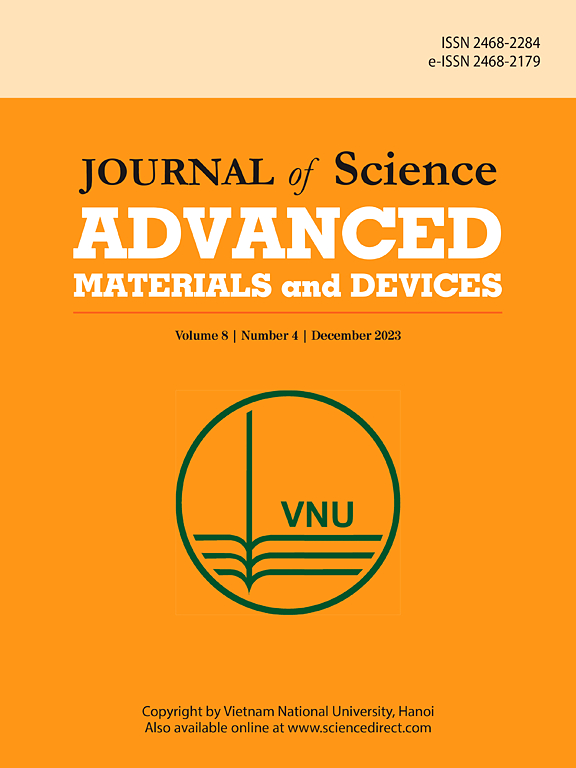Comparative analysis of microlens array formation in fused silica glass by laser: Femtosecond versus picosecond pulses
IF 6.7
3区 材料科学
Q1 MATERIALS SCIENCE, MULTIDISCIPLINARY
Journal of Science: Advanced Materials and Devices
Pub Date : 2024-10-18
DOI:10.1016/j.jsamd.2024.100804
引用次数: 0
Abstract
The growing demand for flexible, high-quality fabrication of free-form micro-optics drives the development of laser-based fabrication techniques for both the shape formation and surface polishing of optical elements. In this paper, we performed a thorough and systematic study on fused silica glass ablation using 10 ps and 320 fs duration pulses. Ablation processes for both pulse durations were optimized based on the measurements of the removed material layer thickness and surface roughness, and by analyzing the topographies of ablated cavities to remove material layers as thin as possible with minimum surface damage. Our findings demonstrate higher process resolution and surface quality for femtosecond pulses. Ablation of pre-roughened glass reduced the minimal removable glass layer thickness well below the 1 μm mark for both pulse durations, improving the process resolution. The minimal removable glass layer thickness was 14 times smaller for the femtosecond pulses, with up to 4.5 times lower surface roughness compared to samples processed with picosecond pulses. On the other hand, results revealed faster glass removal rates with picosecond pulses. In the end, arrays of microlenses were fabricated with both pulse durations and subsequently polished with a CO2 laser. Results revealed higher performance of microlenses fabricated with femtosecond pulses, providing better focusing capabilities and lesser beam scattering. Finally, this study demonstrated the successful fabrication of free-form optical elements with femtosecond and picosecond pulses, demonstrating the versatility and the potential of laser-based techniques.
激光在熔融石英玻璃中形成微透镜阵列的比较分析:飞秒脉冲与皮秒脉冲的比较
对灵活、高质量地制造自由形态微光学器件的需求日益增长,推动了基于激光的光学元件形状形成和表面抛光制造技术的发展。在本文中,我们使用 10 ps 和 320 fs 持续时间脉冲对熔融石英玻璃烧蚀进行了全面系统的研究。根据对去除的材料层厚度和表面粗糙度的测量结果,并通过分析烧蚀腔的形貌,对这两种脉冲持续时间的烧蚀过程进行了优化,以去除尽可能薄的材料层,同时将表面损伤降到最低。我们的研究结果表明,飞秒脉冲具有更高的工艺分辨率和表面质量。在两种脉冲持续时间下,对预粗化玻璃的烧蚀都能将最小可去除玻璃层厚度大大降低到 1 微米以下,从而提高了工艺分辨率。与使用皮秒脉冲处理的样品相比,飞秒脉冲的最小可去除玻璃层厚度减少了 14 倍,表面粗糙度降低了 4.5 倍。另一方面,结果显示皮秒脉冲的玻璃去除率更快。最后,用这两种脉冲持续时间制作了微透镜阵列,然后用二氧化碳激光器进行抛光。结果显示,使用飞秒脉冲制造的微透镜性能更高,聚焦能力更强,光束散射更少。最后,这项研究成功地利用飞秒和皮秒脉冲制作了自由形态光学元件,展示了激光技术的多功能性和潜力。
本文章由计算机程序翻译,如有差异,请以英文原文为准。
求助全文
约1分钟内获得全文
求助全文
来源期刊

Journal of Science: Advanced Materials and Devices
Materials Science-Electronic, Optical and Magnetic Materials
CiteScore
11.90
自引率
2.50%
发文量
88
审稿时长
47 days
期刊介绍:
In 1985, the Journal of Science was founded as a platform for publishing national and international research papers across various disciplines, including natural sciences, technology, social sciences, and humanities. Over the years, the journal has experienced remarkable growth in terms of quality, size, and scope. Today, it encompasses a diverse range of publications dedicated to academic research.
Considering the rapid expansion of materials science, we are pleased to introduce the Journal of Science: Advanced Materials and Devices. This new addition to our journal series offers researchers an exciting opportunity to publish their work on all aspects of materials science and technology within the esteemed Journal of Science.
With this development, we aim to revolutionize the way research in materials science is expressed and organized, further strengthening our commitment to promoting outstanding research across various scientific and technological fields.
 求助内容:
求助内容: 应助结果提醒方式:
应助结果提醒方式:


